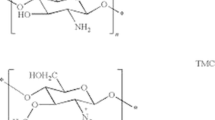Abstract
Purpose. To evaluate the uptake of chitosan molecules (fCS) and nanoparticles (fNP), and their ability to mediate insulin transport in Caco-2 cell monolayers.
Methods. Cell-associated fCS and fNP were evaluated by fluorometry, trypan blue quenching, and confocal microscopy using FITC-labeled chitosan. Chitosan-mediated transport of FITC-labeled insulin was studied in Caco-2 cell monolayers cultured on permeable inserts.
Results. Caco-2 cells showed twofold higher association with fNP than fCS after 2-h incubation with 1 mg/ml samples. fNP uptake was a saturable (Km 1.04 mg/ml; Vmax 74.15 μg/mg/h), concentration- and temperature-dependent process that was inhibited by coadministered chlorpromazine. fCS uptake was temperature dependent, but was less sensitive to concentration and was inhibited by filipin. Postuptake quenching with 100 μg/ml of trypan blue suggests a significant amount of intracellular fNP, although the bulk of fCS was extracellular. Internalized fNP were located by confocal microscopy at 15 μm from the apical membrane, but there was no apparent breaching of the basal membrane. This might explain the failure of the nanoparticles to mediate significant insulin transport across the Caco-2 cell monolayer.
Conclusions. Formulation of chitosan into nanoparticles transforms its extracellular interactions with the Caco-2 cells to one of cellular internalization via clathrin-mediated endocytosis.
Similar content being viewed by others
References
N. G. Schipper, S. Olsson, J. A. Hoogstraate, A. G. deBoer, K. M. Vårum, and P. Artursson. Chitosan as absorption enhancers for poorly absorbable drugs 2: mechanisms of absorption enhancement. Pharm. Res. 14:923-929 (1997).
A. F. Kotéez. H. L. Lueβen, A. G. deBoer, J. C. Verhoef, and H. E. Junginger. Chitosan for enhanced intestinal permeability: Prospects for derivatives soluble in neutral and basic environments. Eur. J. Pharm. Sci. 159:243-253 (1997).
R. Fernandez-Urrusuno, P. Calvo, C. Remunan-Lopez, J. L. Vila-Jato, and M. J. Alonso. Enhancement of nasal absorption of insulin using chitosan nanoparticles. Pharm. Res. 16:1576-1581 (1999).
H. Q. Mao, K. Roy, V. L. Troung-Le, K. A. Janes, K. Y. Lin, Y. Wang, and J. T. August. and K.W. Leong. Chitosan-DNA nanoparticles as gene carriers: synthesis, characterization and transfection efficiency. J. Control. Rel. 70:399-421 (2001).
A. M. Dyer, M. Hinchcliffe, P. Watts, J. Castile, I. Jabbal-Gill, R. Nankervis, A. Smith, and L. Illum. Nasal delivery of insulin using novel chitosan based formulations: a comparative study in two animal models between simple chitosan formulations and chitosan nanoparticles. Pharm. Res. 19:998-1008 (2002).
M. Huang, Z. Ma, E. Khor, and L. Y. Lim. Uptake of FITC-chitosan nanoparticles by A549 cells. Pharm. Res. 19:1486-1492 (2002).
S. McClean, E. Prosser, E. Meehan, D. O'Malley, N. Clarke, Z. Ramtoola, and D. Brayden. Binding and uptake of biodegradable poly-DL-lactide micro-and nanoparticles in intestinal epithelia. Eur. J. Pharm. Sci. 6:153-163 (1998).
I. Behrens, A. I. Pena, M. J. Alonso, and T. Kissel. Comparative uptake studies of bioadhesive and non-bioadhesive nanoparticles in human intestinal cell lines and rats: the effect of mucus on particle adsorption and transport. Pharm. Res. 19:1185-1193 (2002).
C. P. Wan, C. S. Park, and B. H. S. Lau. A rapid and simple microfluorometric phagocytosis assay. J. Immunol. Methods 162:1-7 (1993).
S. Sahlin, J. Hed, and I. Rundquist. Differentiation between attached and ingested immune complexes by a fluorescence quenching cytofluorometric assay. J. Immunol. Methods 60:115-124 (1983).
A. R. Hilgers, R. A. Conradi, and P. S. Burton. Caco-2 cell monolayers as a model for drug transport across the intestinal mucosa. Pharm. Res. 7:902-910 (1990).
P. Artursson. and J. Karlsson. Correlation between oral drug absorption in humans and apparent drug permeability coefficients in human intestinal epithelial Caco-2 cells. Biochem. Biophys. Res. Commun. 175:880-885 (1991).
Z. Ma, H. H. Yeoh, and L. Y. Lim. Formulation pH modulates the interaction of insulin with chitosan nanoparticles. J. Pharm. Sci. 91:1396-1404 (2002).
R. B. Qaqish and M. M. Amiji. Synthesis of a fluorescent chitosan derivative and its application for the study of chitosan-mucin interactions. Carbohyd. Polym 38:99-107 (1999).
L. Thiele, B. Rothen-Rutishauser, S. Jilek, H. Wunderli-Allenspach, and H. P. Merkle. and E. Walter Evaluation of particle uptake in human blood monocyte-derived cells in vitro. J. Control. Rel. 76:59-71 (2001).
A. F. Kotéez and B. J. deLeeuw. H. L. Lueβen, A. G. deBoer, J. C. Verhoef, and H. E. Junginger. Chitosan for enhanced delivery of therapeutic peptides across intestinal epithelia: in vitro evaluation in Caco-2 cell monolayers. Int. J. Pharm. 159:243-253 (1997).
P. A. Orlandi and P. H. Fishman. Filipin-dependent inhibition of cholera toxin: evidence for toxin internalization and activation through caveolae-like domains. J. Cell Biol. 141:905-915 (1998).
A. Sofer and A. H. Futerman. Cationic amphiphilic drugs inhibit the internalization of cholera toxin to the Golgi apparatus and the subsequent elevation of cylic AMP. J. Biol. Chem. 270:12117-12122 (1995).
K. G. Rothberg, Y. S. Ying, B. A. Kamen, and R. G. Anderson. Cholesterol controls the clustering of the glycophospholipid-anchored membrane receptor for 5-methyltetrahydrofolate. J. Cell Biol. 111:2931-2938 (1990).
D. Shah and W. C. Shen. Transcellular delivery of an insulin–transferrin conjugate in enterocyte-like Caco-2 cells. J. Pharm. Sci. 85:1306-1311 (1996).
Author information
Authors and Affiliations
Corresponding author
Rights and permissions
About this article
Cite this article
Ma, Z., Lim, LY. Uptake of Chitosan and Associated Insulin in Caco-2 Cell Monolayers: A Comparison Between Chitosan Molecules and Chitosan Nanoparticles. Pharm Res 20, 1812–1819 (2003). https://doi.org/10.1023/B:PHAM.0000003379.76417.3e
Issue Date:
DOI: https://doi.org/10.1023/B:PHAM.0000003379.76417.3e




